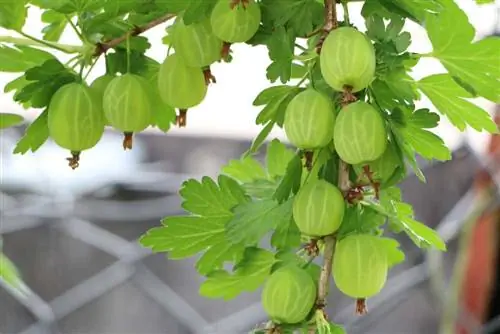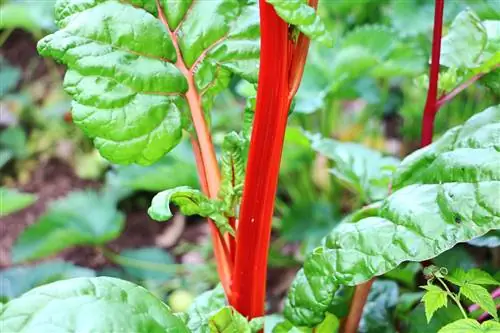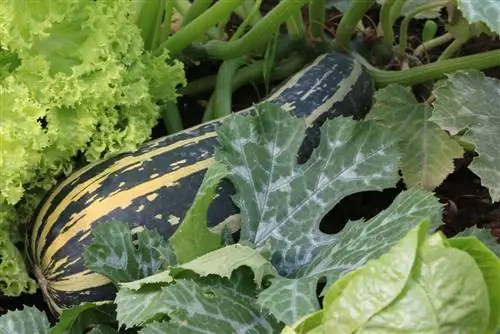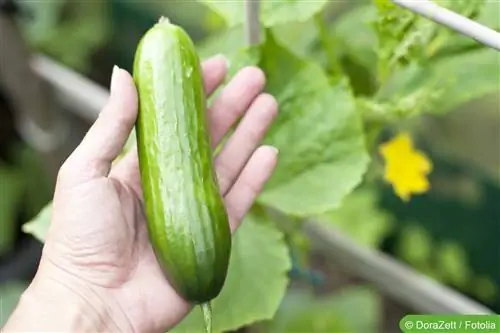- Author admin [email protected].
- Public 2023-12-17 03:39.
- Last modified 2025-01-24 12:45.
The anticipation is great when the auspicious berries gather in droves on the gooseberry bush. It's good to know that the tempting fruits don't insist on a fixed harvest date. Rather, the variety and intended use determine the ideal time. It can even be an advantage to pick gooseberries when they are half ripe. Get to know all the options here for carefree enjoyment of home-grown fruit. These instructions explain when and how to properly harvest the berries.
Harvest window opens at the end of June
The long cultural history of gooseberries provides the modern home gardener with a variety of tried and tested varieties that are characterized, among other things, by staggered ripening times. In this context, the very early flowering period from April offers greater flexibility than with later-flowering soft fruit types. Since selection began in monastery and farm gardens in the 16th century, there is now a suitable gooseberry variety available for almost every taste and harvest requirement. The only limits are the climatic conditions in Central Europe. When choosing a variety, you can therefore have a certain influence on when your gooseberries are ready to harvest. The following overview shows the options:
- Höning's earliest: ripe from the end of June/beginning of July
- Rokula: ripe from the beginning/mid of July
- Rolanda: ripe from mid/end of July
- White Triumph: ripe from mid-July
- Red Triumph: ripens one to two weeks later than the sister variety
- Reflamba: ripe from the end of July/beginning of August
This representative list shows that with a clever combination of early, medium-late and late varieties, the window for harvesting gooseberries remains open from June to August.
Tip:
Early ripening gooseberry varieties rely on a late frost-protected location with deep, well-drained soil. A semi-shady location is advantageous so that the berries do not suffer sunburn under intense spring sun.
Different stages of ripeness determine the taste experience
When it comes to the specific day for the harvest, gooseberries once again prove their flexibility. As they ripen, the varieties offer different taste treats, depending on the current condition of the berries. If you want the invigorating effect of a sour fruit taste, pick the berries a little earlier. If you prefer the experience of fruity sweetness, the gooseberries should be pampered by the sun a little longer.
Only a pressure test provides the best answer to your question: When are gooseberries ripe?
How to do it:
- Grasp the berry to be tested between your index finger and thumb
- Apply light pressure to the bowl with both fingers
- Hard skin and hard pulp: sour taste for die-hard gooseberry fans
- Hard skin and soft flesh: crunchy enjoyment with a fruity-sour aroma
- Soft skin and flesh: the sweetest taste gooseberries have to offer
But be careful:
Overripe gooseberries often burst open, which not only affects their appearance. If you wait too long to harvest, the berries will disappoint you with a taste that is reminiscent of soap.

Furthermore, the intensity of the peel color provides information about the ripeness of a gooseberry. Green varieties are light green in the early, sour stage. When fully ripe, the peel takes on a yellow color. White varieties owe their name to the fact that they appear almost transparent when fully ripe. Red varieties signal a sour taste when they are still greenish-red in color. Only with their dark, rich red color do these gooseberries promise maximum sweetness.
Green pickings for jam and compote
Fully ripe gooseberries are primarily suitable for fresh consumption as they can only be stored for a short time. In addition, their pectin content is at its lowest level at the time when they are ready for consumption. To cook ripe gooseberries into jam or compote, large amounts of preserving sugar must be added. This doesn't have to be the case, because half-ripe fruits have a high pectin content, which reduces or even completely eliminates the need for additional gelling agents.
To preserve gooseberries in a natural, he althy and low-calorie way, harvest some of the still green fruits in mid-May. In this way, you save the addition of preserving sugar or other gelling agents. On the other hand, the remaining berries have optimized access to sunlight and more space for their growth. When fully ripe, this results in larger gooseberries with a higher fructose content, which makes eating fresh more enjoyable.
Tip:
Smart housewives use green-picked gooseberries as a natural gelling agent to preserve low-pectin fruits, such as strawberries, cherries or blackberries.
Harvest gooseberries correctly
Once you have carefully determined the perfect time for the harvest, there is one last hurdle to overcome before you can enjoy the fruit. Many premium varieties are armed with thorns that leave painful scratches on the skin. To avoid this nuisance, you should not approach the defensive berry bushes unprotected. How to harvest your gooseberries correctly:
- Thorn-proof gloves covered with long cuffs over the elbow
- Protect your legs with high rubber boots
- Ideally wear safety glasses
- Grasp the branch with one hand and pull it up
- Pick the gooseberries with the other hand
Knowledgeable breeders have fulfilled the desire for thornless gooseberry varieties in a large selection. If you don't want to bother with cumbersome protective measures, grow unreinforced shrubs. Well-known varieties are Spinefree and Larell, with sweet, red fruits. However, avoiding thorns usually comes at the expense of profitability. Therefore, home gardeners like to opt for a compromise and grow varieties with few thorns. A prime example is Redeva, a mass bearer with large, purple gooseberries and low reinforcement.
Conclusion
No home gardener wants to miss out on their sour, fruity taste buds, because the planting plan and orchard is only complete with gooseberries. So that the enjoyment of the fruit does not end in disappointment, the date for the harvest should be chosen carefully. At the end of June, the earliest of all varieties, Höning's Earliest, opens the window for harvesting, which only closes with late varieties, such as Reflamba, at the beginning of August. Fully ripe, well-colored berries with soft skin and soft flesh are unbeatably delicious when eaten fresh. In the days and weeks before, gooseberries provide the sour kick of freshness, the skin of which is still firm when lightly pressed with your finger. The green picking begins in mid-May and gives you half-ripe gooseberries with such a high pectin content that you don't have to add any or very little preserving sugar to prepare jam and compote. So that skin injuries caused by the thorns do not cast a shadow on the juicy gooseberry enjoyment, please wear protective clothing when harvesting or simply grow non-reinforced varieties.






